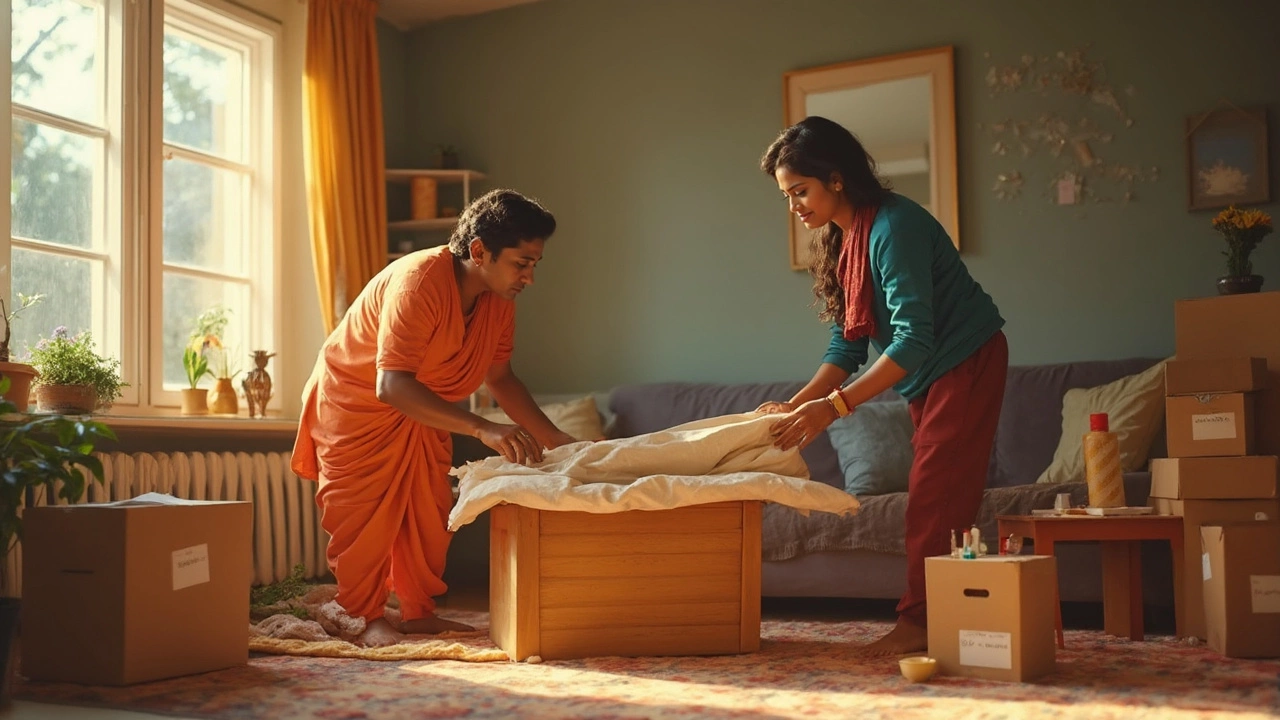Storing furniture sounds simple until you crack open your storage unit and find greenish fuzz growing on your favorite couch. Mold isn't picky—it’ll attack wood, fabric, or leather alike if you leave the door open (sometimes literally) for moisture and stale air. Spotting the root causes is the first step to stopping it.
Humidity is the mold’s best friend. If the air gets damp and still, mold spores will settle in before you know it. Most mold problems in storage pop up after rainy seasons or if a unit sits in a basement with little ventilation. Random fact: Mold spores can start growing in less than 48 hours when the humidity is high enough. One decent storm and, boom, your stuff is at risk.
But you don’t have to just cross your fingers and hope for the best. Start by checking the storage spot itself. Is it in a flood zone? Does it have any wet spots or musty smells? If you smell that classic musty odor, mold is probably already making itself at home.
- Why Furniture Gets Moldy in Storage
- Prepping Furniture Before Storage
- Smart Storage Setup to Stop Mold
- Spotting and Handling Mold Early
Why Furniture Gets Moldy in Storage
Mold is sneaky—and it doesn’t take much to make your furniture its new home. The real culprit behind mold is moisture. When humidity gets above 60%, the risk of mold shoots up fast, especially inside closed-off corners of a storage unit. That’s why folks storing furniture for months (or years) often come back to nasty surprises.
Different materials don’t stand a chance if moisture sticks around. Leather pulls in humidity and can develop spots. Wood soaks it up like a sponge, making cracks and crevices in wood furniture mold magnets. Fabric acts the same way. If you store a couch or a mattress when it’s even a little bit damp, mold can start growing in less than two days. The whole point here: even a bit of water or steam inside your storage unit opens the door for trouble.
"Mold growth in storage areas comes down to a mix of humidity, low airflow, and organic materials like wood, leather, or cotton. Control these three factors, and you’re already ahead of the game." — National Institute of Environmental Health Sciences
Here’s a breakdown of the main reasons you end up with mold on your stuff in storage:
- High humidity trapped inside the storage space (60%+ is asking for it)
- Lack of ventilation—no fresh air means moisture lingers
- Stored items weren’t completely dry beforehand
- Units in flood-prone or basement spots get damp from the ground up
- Prolonged storage—mold spores just need time and moisture to set up camp
Check out these numbers from a recent climate control study. It shows how much humidity ramps up the risk of mold on your belongings:
| Humidity Level (%) | Risk of Mold Growth (%) |
|---|---|
| Below 50 | Very Low |
| 50–60 | Low |
| 60–70 | Moderate |
| 70+ | High |
So if you live somewhere muggy or have an older storage unit, keeping things dry becomes mission critical. Even tiny leaks, heavy rainfall, or poor airflow can push your storage space into mold territory overnight.
Prepping Furniture Before Storage
Don’t just shove your stuff in and hope for the best. The big secret to beating mold starts before you even drag your furniture into a storage unit. Whether it’s Grandma's old chest or that cheap IKEA couch, all furniture needs a little TLC first.
First, you’ve got to clean every piece like your security deposit depends on it. For wood or hard surfaces, use a mild detergent, then wipe it down with a little bit of vinegar mixed in water—nothing too punishing, just enough to kill any lurking spores. Fabric items need a good vacuum and, if possible, a go with a fabric-safe cleaner. For leather, grab a cleaner and conditioner that'll keep it sealed against moisture. Don’t forget the undersides and hidden corners—mold loves a good hiding spot.
After cleaning, hours matter. Furniture should be 100% dry before you store it. A little leftover dampness, and you’re practically handing mold an invitation. Here’s a handy timeline to keep in mind:
| Material | Recommended Drying Time |
|---|---|
| Fabric (sofa, chairs) | 24-48 hours |
| Wood furniture | At least 24 hours |
| Leather items | 12-24 hours |
Once dry, disassemble whatever you can—legs off tables, cushions out of couches. Smaller pieces are easier to wrap tightly, which stops moisture from sneaking in. Plastic wrap or moving blankets work, but skip sealing covers airtight; furniture still needs to breathe a bit. Wrap cushions in cotton sheets instead of plastic—mold can grow faster if there’s no airflow.
Here’s a quick checklist for prepping your items so you can protect furniture from mold like a pro:
- Clean and completely dry every item
- Use vinegar for wood and mild cleaner for upholstery
- Disassemble when possible for better coverage
- Wrap with moving blankets or sheets
- Avoid airtight plastic bags for anything that can trap moisture
- Check all corners, gaps, and the underside for sneaky damp spots
It’s not rocket science, but if you skip these basics, mold is going to win. These steps buy you peace of mind and a fresh-smelling storage unit.

Smart Storage Setup to Stop Mold
If you want to keep furniture safe, you need to pay attention to the basics, starting with climate control. A climate-controlled storage unit is like your insurance policy against mold. Humidity under 60% is the sweet spot—most regular storage units easily top that when it’s humid outside. If your space doesn’t have its own controls, consider running a dehumidifier or putting moisture absorbers (like those DampRid tubs) right on the floor. Silica gel packets tossed inside drawers and storage bins help too.
Next, how you stack and position stuff matters. Never put furniture tight up against a wall—leave at least two or three inches to let air flow all around. The more air movement, the less chance for moisture to settle. Stick pallets under your furniture so it’s not hugging the concrete or tile floor (which attracts condensation and stays cooler). Raised up, your stuff dodges leaks or puddles if water gets in during a heavy rain.
Give fabric surfaces air, and don’t wrap them in plastic. I know it sounds smart, but plastic traps moisture, turning your couch into a greenhouse for mold. Breathable covers—think cotton sheets—keep dust away without sealing in dampness. For wood or leather, light covers are better than none, but really check that no plastic is locking in humidity.
- Climate control keeps humidity below 60% (ideal for stopping mold growth).
- Keep furniture off the floor using pallets or racks.
- Leave gaps between items and walls for airflow.
- Opt for breathable covers instead of anything plastic or waterproof.
- Stick moisture absorbers or silica gel packs inside drawers, closets, or storage bins.
Check this quick table for what works and what doesn’t:
| Action | Mold Risk | Pro Tip |
|---|---|---|
| Plastic wrap on upholstery | High | Use cotton sheets instead |
| Raised on pallets | Low | Keeps pieces dry if water leaks in |
| Direct contact with walls | Medium | Always leave a gap |
| No airflow in unit | High | Use a fan or vent if possible |
| Silica gel in drawers | Low | Replace packs every few months |
The real trick is regular checks—don’t just stash and forget. Drop by every month or two and make sure everything’s still dry and clean. If you act fast at the first sign of moisture, you’ll never have to deal with a mold in storage disaster.
Spotting and Handling Mold Early
Mold isn’t shy about showing up if you give it the chance, so you have to check your stuff often, not just stash and forget. It usually starts with a musty smell, a bit like wet socks, or you might spot fuzzy patches, often green, white, or black, on your furniture. If you see speckled stains or discoloration that feels slightly damp, that’s your sign to act fast.
Research shows over 50% of furniture damage in basic, non-climate-controlled storage spots is due to hidden mold, but the good news is early action stops it from spreading. Here’s what you need to do the minute you notice anything weird:
- Take everything out and take a good look at the undersides, inside drawers, and around the edges where mold loves to settle first.
- If you’re seeing mold, move the affected piece outdoors if you can. Sunlight helps kill spores and cuts back on that damp, musty feeling.
- Wipe the area with a damp microfiber cloth—skip sponges, since they spread spores around.
- Mix a cleaning solution: 1 cup of white vinegar plus 1 cup of water tackles most mold, or use 70% rubbing alcohol. Don’t bother with strong perfumes; you want stuff that kills, not just covers the smell.
- If the item is fabric, don’t soak it. Lightly mist and scrub, then air dry in the sun.
- Masks and gloves keep you from breathing in spores or rubbing them in your skin.
Sometimes, you get mold that won’t budge. For solid wood or expensive pieces, let pros handle it. DIY can damage finishes if you go too hard. And if you keep getting recurring spots, the storage area may be too humid or has leaks.
Keep a simple table like this handy so you know what to watch for and how quick you need to act:
| Warning Sign | What It Means | Action to Take |
|---|---|---|
| Musty smell | Mold is starting somewhere nearby | Inspect all furniture, step up air flow |
| Green/black patches | Visible mold—act immediately | Clean with vinegar, air dry outdoors |
| Damp feeling surfaces | Humidity is too high | Use moisture absorber/dehumidifier |
Checking your protect furniture system every month, especially after rainy weeks, makes sure mold never has a real shot at claiming your stuff. Treat early—your furniture (and your nose) will thank you.

